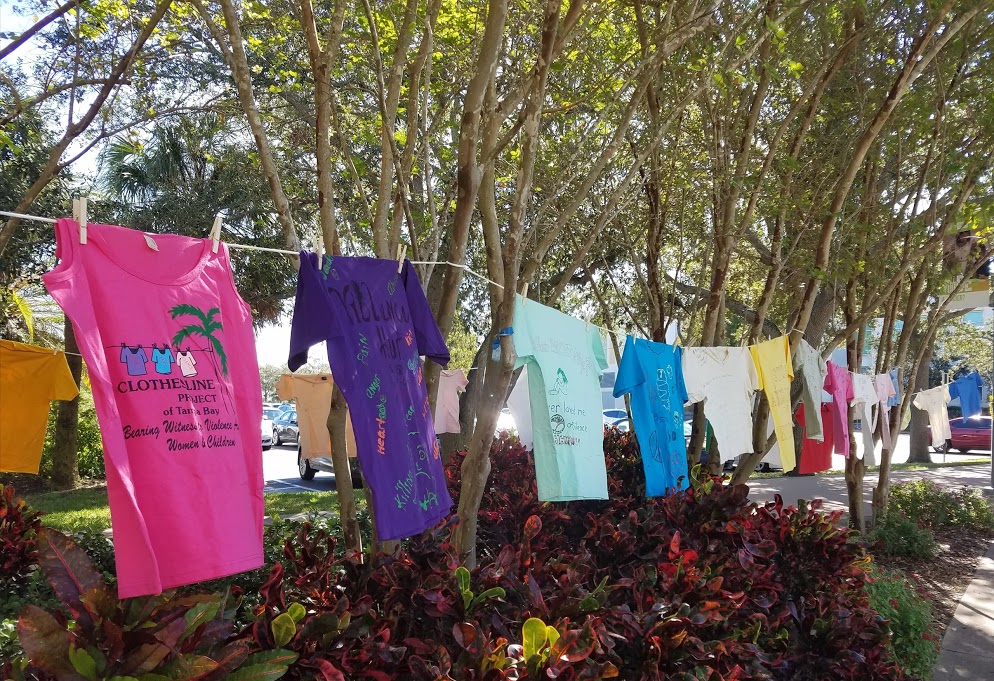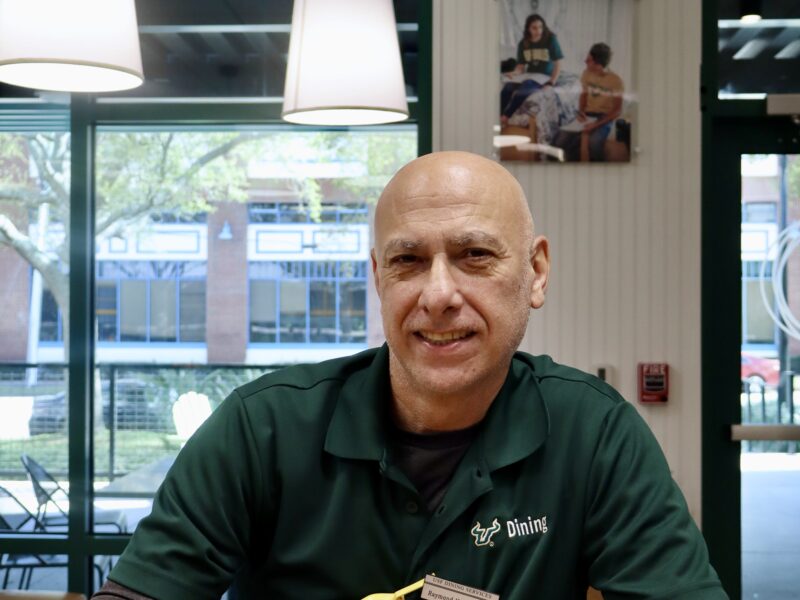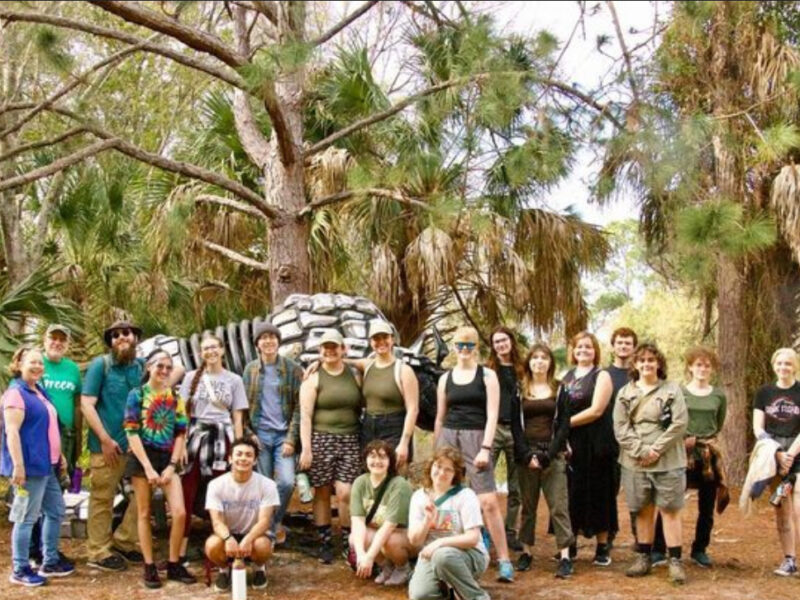By Karlana June
Still reeling from a post-traumatic stress disorder episode, I am apprehensive about obligations requiring me to be on campus.
Cinder blocks seem to replace my feet as I take each slow and cautious step across the Peter Rudy Wallace courtyard. As I enter the foyer, feeling naked and vulnerable, I see a familiar sight beyond the glass doors.
Dancing colorfully in the crisp, morning breeze, T-shirts hang on clotheslines.
They’re part of the Clothesline Project — a visual display that bears witness to the violence against women, men and children.
The project was conceived in 1990, when members of the Cape Cod Women’s Agenda learned that during the Vietnam War years — when 58,000 American military personnel were killed — 51,000 women were killed in the U.S. by men due to domestic violence.
October is Domestic Violence Awareness Month. Community Action Stops Abuse (CASA), the official domestic violence center for southern Pinellas County, is the Clothesline Project of Tampa Bay (CPoTB) curator for this exhibit.
The first Clothesline Project comprised 31 shirts. Almost thirty years later, there are Clothesline Projects in 41 states and five countries, with an estimated 500 projects and 60,000 shirts.
There are no longer cinder blocks attached to my feet as I deposit my backpack in the office and make my way toward Harborwalk. The Clothesline Project beckons me with a magnetic force.
It is unequivocally comforting.

I am surrounded by a multitude of fellow survivors and victims of domestic and sexual violence. Our voices, bold and brave, dance on the gusts of wind as the sunlight catches glitter on some of the shirts. Light and free.
As I approach the exhibit, Hong Callueng, a CASA volunteer, is at my side. “Do you know about the Clothesline Project?” she asks.
“Yes. I decorated a shirt several years ago,” I say.
Hong’s eyes well up and I am engulfed in her arms. No words are necessary.
The clothesline stretches nearly the length of Harbor walk. Spanning both sides — around 150 shirts (an estimated 1,110 in the full CPoTB collection) on exhibit. I am hoping to find my shirt, but know there are so many, often space doesn’t allow for all the shirts to be displayed.
Dawn Hoang, a senior business management major, is another CASA volunteer overseeing the exhibit on campus. She wanted to get involved in the community and decided to volunteer with CASA.
“I feel very open to do (the Clothesline Project) and let students know,” she says.
Hoang is also a volunteer at the CASA thrift store.
Domestic and sexual violence has no bias — it doesn’t discriminate. It affects humans regardless of age, gender identity, race, class or sexual orientation.
I ask Dawn how people’s responses have been.
“Students have been quiet. It is a sensitive topic,” Hoang says.
While I stand observing, far more women than men stop to bear witness. This violence is harder for men to acknowledge and accept. Gender socialization issues are the biggest factor and why males are less likely to report abuse or assault.
“It’s heavy. Heartbreaking,” says Lexi Montero, a freshman biology major who stopped to read the stories.
Dialogue, whether private or public, is uncomfortable for people.
We have been conditioned by society, culture and the media to hide it, cower from it, keep silent about it, shove it under the proverbial rug.
Survivors are often coerced into silence. When we tell someone we trust, often we are not believed or accused of somehow being responsible for the violence. Family, police and friends are guilty of this.
Many of us suppress the trauma or numb the effects with drugs and alcohol, self-harming, and tragically, sometimes suicide. We often repeat the violence by entering violent relationships, being promiscuous or putting ourselves in dangerous situations.
Why would survivors retraumatize themselves or keep silent?
Because the violence is what we know. It is insidious. Perpetrators enforce objectification, shame, guilt, worthlessness — that we don’t matter. We carry this with us.
RAINN (Rape, Abuse & Incest National Network) reports that every 98 seconds a person experiences sexual assault in the U.S. Every eight minutes, the victim is a child.
“This is my shirt! I found my shirt!” I say to Hong, overwhelmed by this gift, on this day — validation that my story and voice matters. It is empowering.
The date when I created my shirt is scrawled along the bottom, “5/05,” the first time I shared my story publically. The CPoTB offered an empowering outlet to express my trauma in a safe an anonymous way.
Twelve years have passed. Through trauma therapy and counselling, talking about it, and being willing to walk through the pain of the trauma, I am at peace today. I have a voice and use it to educate others, encouraging survivors to find their voice, to speak up and speak out.
From victim to survivor. From broken to healed. From voiceless to boisterous. I will always live with PTSD, but I am no longer defined by these experiences — they are simply part of what makes me, ME.
If you are a survivor of domestic or sexual violence, talk about it. Talking about it is the first step toward healing.
If someone trusts you enough to talk about what happened to them, listen, support and love them through the trauma. Ask the survivor how you can best support them.
“I am a daughter and I have a daughter, a sister, and this touches me deeply. It’s liberating to be a voice. I can use my voice to share other’s stories,” says Hong.
Pictured Above: The Clotheslines Project creates a powerful visual with T-shirts containing designs made by survivors of domestic and sexual abuse. Karlana June | The Crow’s Nest



